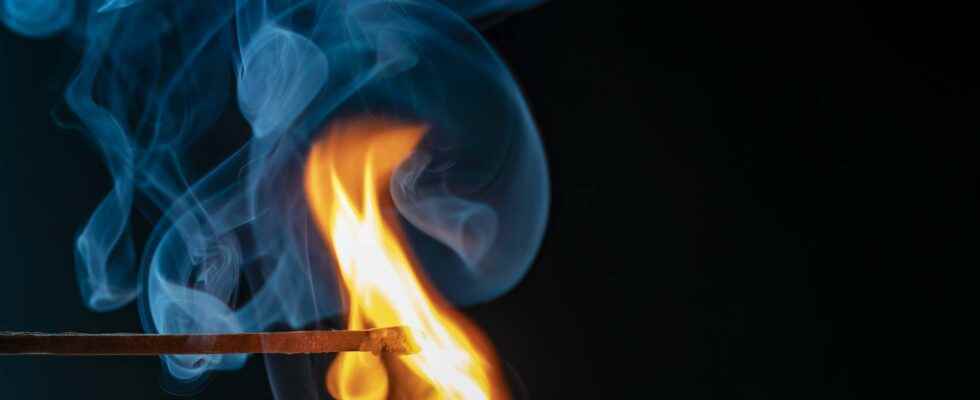You will also be interested
[EN VIDÉO] Incredible Chemistry Experiments: Colored Flames The fireworks. Their colors that light up the sky make our children’s eyes shine. And ours, let’s face it. Behind the magic, some very simple chemical reactions. Video explanations by Maëlle Mosser, doctor in chemistry at ENS de Lyon.
We handle it every day, or almost: the fire has been used by humans for over 400,000 years. But, in space, everything is different, and its behavior too. This is what researchers from the Nasa who created the project Advanced Combustion via Microgravity Experiments, Where Acme, spread over four and a half years. Thus, since 2017, astronauts aboard the International Space Station (ISS) experiment around this theme.
“An environment of microgravity allows researchers to explore the behavior of flames without the influence of gravityso that they can study the physical underlying structure and behavior of flamessaid Dennis Stocker, Acme project scientist at Nasa. This knowledge can help designers and engineers here on Earth develop furnaces, power plants, boilers and other combustion more efficient, less polluting and safer. »
In microgravity, the flames are spherical!
On the program, six experiments covering different themes, but with one thing in common: they generate scattering flamesor not premixed, i.e. when the combustible and the oxidizerneeded in addition to a source of heat for the fire to form, are separated before ignition. This is the case for candles, for example, where the fuel is wax, the oxidant theoxygen surrounding, and the activation energy the flame from a lighter or a matches. “More than 1,500 flames were lit, more than three times the number originally plannedsaid Dennis Stocker. Several “firsts” have also been made, perhaps more particularly in the areas of cold and spherical flames. »
Already created in 2012 with combustibles liquids, this time the flames were made only with gaseous fuels. But the main result is the same: the flame takes on a spherical shape, very different from the one we usually know. In question, the absence of gravity: on Earth, hot air rises by convection because it is less dense, and the cold air descends by gravity and feeds the base of the flame. But these phenomena do not come into play on board the ISS. The products of combustion no longer descend by gravity, and then remain all around the flame: oxygen is brought in from all sides, provided movements enough air for the CO2 let him pass. In this case, the flame is maintained.
Six experiments to understand the dynamics of fire in microgravity
Altogether, these six experiments impossible to perform in a terrestrial laboratory have considerably improved the computer models that simulate the growth and theextinction flames in a microgravity environment. A fire created in space will be more stable, and therefore, more difficult to put out. It is for this purpose that NASA carried out these tests: prevent fires, and better understand the dynamics of fire in microgravity. Especially in spacecraft, where everything is confined and where an unmanaged fire quickly becomes catastrophic.
Among these tests, cold flames were carried out, an experiment that had already been carried out in 2012 on board the ISS. But also, the burning Missed Simulator (BRE) consisted of igniting different materials in a atmosphere at rest, then to observe the ignition and to carry out various extinguishing tests. Several fuels have been used, in different atmospheres, in conditions similar to those envisaged for future space exploration”.
During the s-Flame experiment, the fuel and the surrounding atmosphere were diluted with helium which replaced the nitrogen. As it is a better thermal conductor than nitrogen, the size of the flame has increased significantly, but also its structure and its dynamics. Analyzes are underway to model it, and thus predict effective extinguishing methods. © Nasa
The case of the sooty flames
Other experiences like Coflow Laminar Diffusion Flame (CLD Flame), made it possible to study the sooty flamesi.e. which generate sootthis polluting blackish-looking substance that results from incomplete combustion of materials carbonated. They found that ” microgravity soot flames are wider and taller than their normal gravity counterparts, and the concentration of soot can be as much as a factor of ten greater.
But that’s not all ! NASA explains that if the fuel is diluted with a gas inert, likenitrogenthen the soot disappears and the flame “may detach from the surface of the burner and appear as a slight cone blue “. In the case of extreme dilution, the flame even takes on the shape of a disc and then goes out. Finally, researchers have shown that a electric field makes it possible to reduce the emissions of diffusion flames: this thanks to the ions created as a result of combustion reactions, which are sensitive to it. Depending on the field applied, the shape of the flame can be modified, until the creation of soot is eliminated.
Reading ideas for the summer with Futura?
To celebrate the start of the holidays, we offer you the Mag Futura at the preferential price of 15 € instead of 19 €, i.e. a reduction of 20% !
What is Mag Futura?
- Our first paper journal of more than 200 pages to make science accessible to as many people as possible
- 4 major scientific questions for 2022, from the Earth to the Moon
- Home delivery*
*Special offer valid until July 19. Delivery is made in France (excluding metropolitan France), Switzerland, Belgium.
Interested in what you just read?
